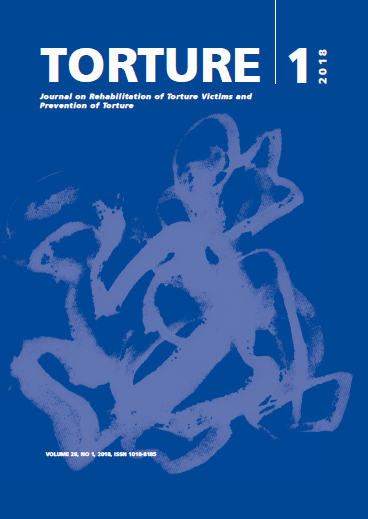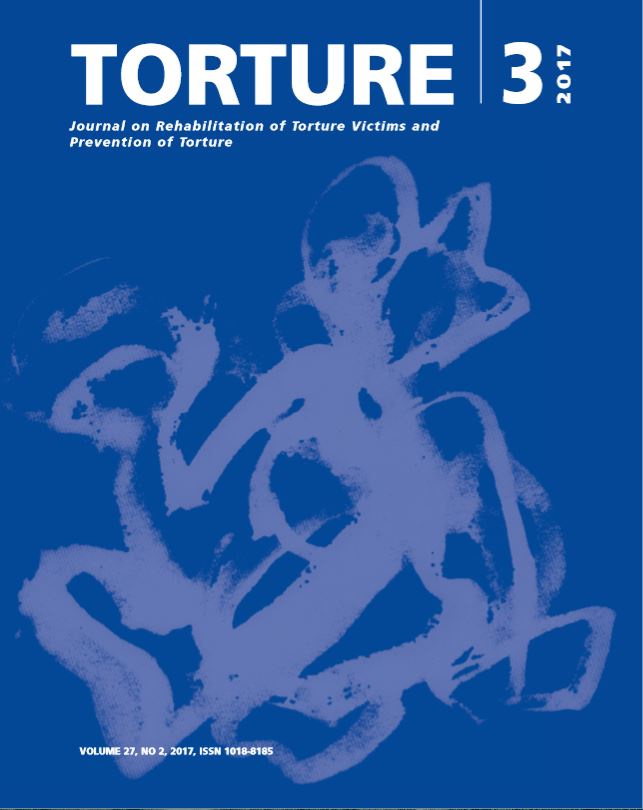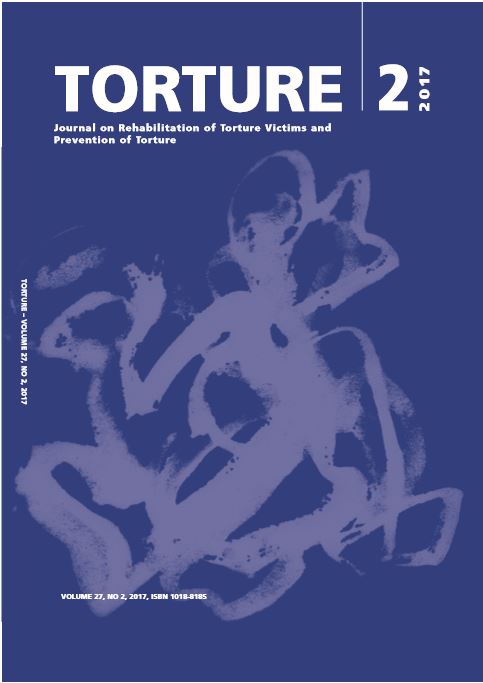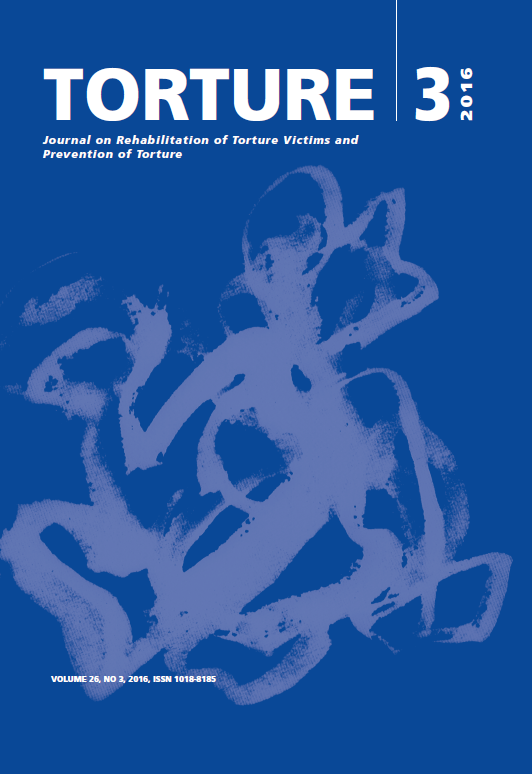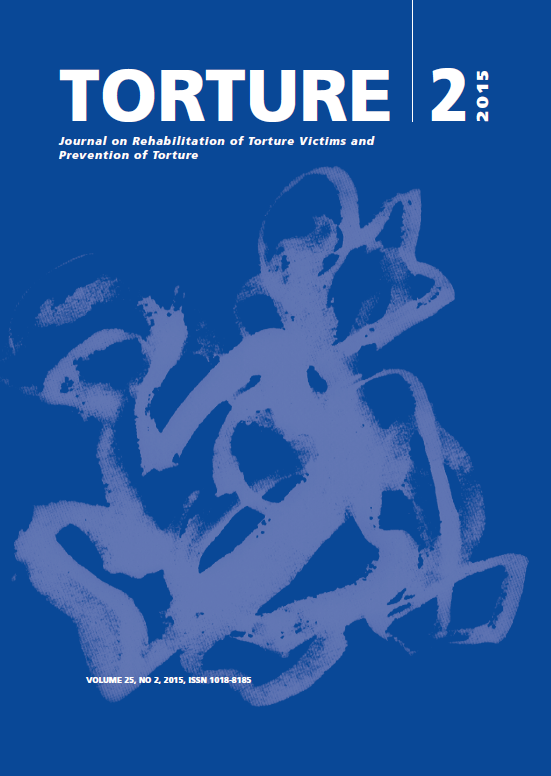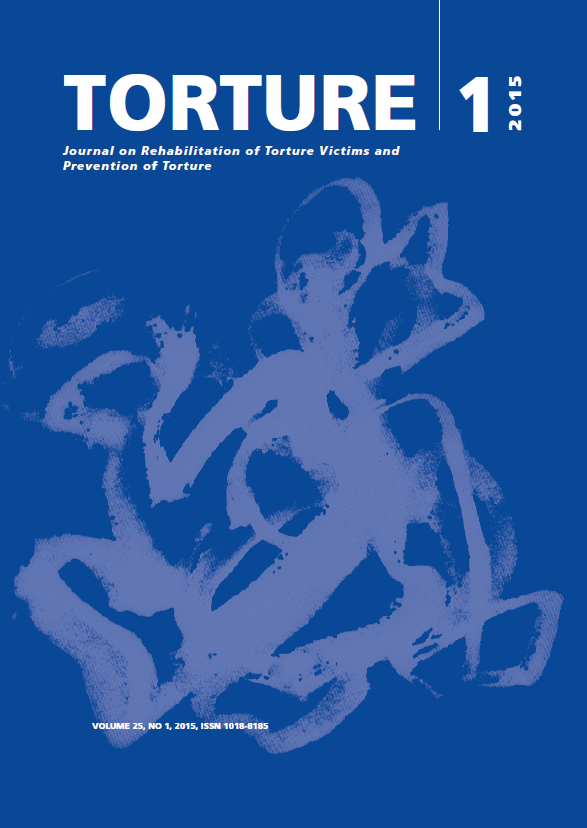Archives
-
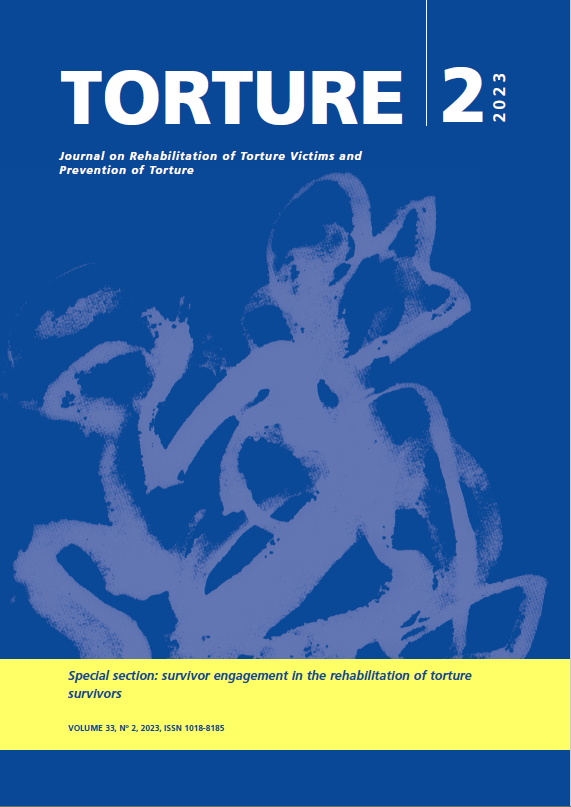
Torture Journal: Journal on Rehabilitaiton of Torture Victims and Prevention of Torture
Vol. 33 No. 2 (2023)Pau Pérez-Sales introduces this issue with an Editorial that provides us with a background of the origins of survivor engagement being historically implemented in the Global South.
The Editorial is followed by the Special Section on Survivor Engagement in the Rehabilitation of Torture Survivors.
Susan Wyatt opens the section with a paper that reflects on the notions of restoring power or ‘agency’ to survivors, discussing different conceptual frameworks and pathways for effective and strategic mechanisms for facilitating ‘agency’ within the spectrum of torture rehabilitation.
Einolf et al. presents a qualitative study that explores current practices, best practices, and the advantages and disadvantages of engaging survivors in the direction and provision of rehabilitation services. It discusses the risks of re-traumatization and presents practices that involve engaging survivors in ways that do not instigate their trauma.
Moreover, Mikel Soto, presents the survivor-lead experience of the Network of Tortured People of Navarre and analyses the keys to this process of collective empowerment, describing the self-organising process of the victims and some lessons that may be useful for other realities and groups of torture victims who want to engage in self-organising processes.
Henceforth, Seini O’Connor and colleagues contribute to the special section with three articles. The first one describes TASSC’s model for engaging survivors in advocacy and presents evidence on the personal impacts such engagement can have. The second one looks at the characteristics of survivors who engage in advocacy in comparison with those who do not. The third one explores survivor engagement in the form of cultural facilitation, drawing on a case example of cultural bridging involving a pilot programme to train torture survivors and former refugees to become cross-cultural facilitators supporting mental health services for displaced communities.
The special section is closed with the contribution from Rachel Hoare, further expanding on the benefits of the befriending programme within Spirasi’s holistic approach and the importance of collaborative expressive arts activities in building befriending relationships. She does that through an empirical study that explores, in complementary ways, the impact of this befriending programme on befrienders and befriendees and incorporates their voices into recommendations for optimising the service.
The perspective section, entails three contributions.
José Quiroga and Ana Deutsch share their personal memories to describe and reconstruct the journey to the development of forensic torture assessment tools, before the existence of the Istanbul Protocol. They review the historical precedents of the Forensic Assessment of Torture Survivors in the US in the 1970s and 1980s, the first model of affidavit developed in Los Angeles, setting the precedents of the US branch of the construction of the Istanbul Protocol that was developed in the late 1990s.
Christian DeVos and colleagues explore extra-carceral governmental actions that constitute torture or ill treatment of socially and economically marginalized populations, advocating for a more contextual approach to the understanding of what constitutes torture or ill treatment, and, consequently, a more expansive interpretation of states’ obligations to prohibit and prevent it under international law. Building on examples that unsettle the conventional understanding of torture focused on carceral and custodial settings, they also offer recommendations for how clinicians and health and human rights researchers, can better elucidate the links among torture, poverty, and vulnerability to hold perpetrators accountable and help states develop laws, policies, and other measures to prevent the perpetration of state-promoted or sanctioned acts of torture or ill treatment.
Daniel Weishut and colleagues present their insights about the use of the Istanbul Protocol in Israel, as collected by a group of experts in the documentation of torture and ill-treatment, at the reception of the revised (2022) version.
This is followed by a book review by Giulia Berta of the volume Migration and Torture in Today’s World, curated by Fabio Perocco and published by Ca’ Foscari Editions in 2023.
This issue also announces Dr. Mahmud Sehwail’s paper “Personal reflection” as the winner of the 2022 CTI Prize, after being the most voted by the IRCT membership and the Torture Journal readership. Congratulations, Dr. Mahmud!
Finally, this issue is concluded with the forthcoming call for papers for the special sections on Livelihoods and Prisons, in which we encourage you all to submit papers, in case you have relevant research and/or experiences to share in these areas.
You, the readers and authors, are responsible for the increasing growth of Torture Journal: a home for all.
We would like to especially thank the authors for their excellent work and contribution to the Torture Journal, and OSSTT and STARTTS for their valuable continued support.
-

Torture Journal: Journal on Rehabilitation of Torture Victims and Prevention of Torture
Vol. 33 No. 1 (2023)What can you find in this issue?
Pau Pérez-Sales and Paula de la Fuente introduce this issue with a quick guide on detection and assessment of victims of torture and ill-treatment in Primary Health Care, incorporating the last advancements of the 2022 Istanbul Protocol.
The Editorial is followed by a section compiling research articles.
Jesús Silva presents a study that describes and classifies the type of torture and ill-treatment in the orofacial area of victims of political repression during the Chilean military dictatorship and relates them to the injuries registered in written reports. It also draws on the psychological impact for victims.
Andrea Galán et al., introduce an exploratory study on the quality of forensic assessments using the Istanbul Protocol in a virtual versus face-to-face environment, through which they assess the advantages and disadvantages of online methodologies for forensic assessments.
İlker Özyıldırım and colleagues, contribute with a study that assesses the effectiveness of psychoanalytic psychotherapy in patients with PTSD as a results of torture and severe human rights violations.
Following these studies, this issue compiles three contributions that conform a special section on forensic documentation of psychological torture.
Given the difficulty to legally substantiate and establish harms produces by threatening acts, as well as to clearly identify the harms that go beyond the fear and stress inherent (hence, unlawful) in law enforcement practices, Pau Pérez-Sales et al. present a Protocol on medico-legal documentation of threats to enhance documentation and assessment of harms so that stronger legal claims can be submitted to local and international complaint mechanisms.
Jane Kilpatrick et al., review the definition and the spectrum of deprivation of sunlight as a method of torture, drawing on the harms caused by this practice that may amount to torture.
Marie Brasholt and colleagues close the special section with the presentation of a Protocol on medico-legal documentation of solitary confinement which seeks to improve documentation of solitary confinement and, hence, to clarify the facts of the case so that stronger legal claims can subsequently be submitted to local and international complaints mechanisms.
In our continuous education section, Olivia Febles Simeon and C. Nicholas Cuneo present the case of MA, a case of a survivor of labour trafficking, kidnapping, and sexual violence in her home country; to demonstrate the value of remote evaluations conducted by health professionals for the purpose of applying for humanitarian parole and prioritizing the most vulnerable cases.
This issue also contains a thematic briefing summarising the key findings and recommendations to the United Nations Working Group following the official presentation of the monographic issue on Enforced Disappearances as Torture in Geneva, together with OMCT, on the 22nd of September.
Moreover, we celebrate the new appointment of our fellow board member, Dr. Alice Edwards, as the new Special Rapporteur against Torture. In this issue, in addition to welcoming her appointment, we include an article written by herself discussing her priorities during her tenure and the role of the Torture Journal.
Finally, this issue also includes the forthcoming call for papers for three special sections on Survivor Engagement, Livelihoods and Prisons, in which we encourage you all to submit papers, in case you have relevant research and/or experiences to share in these areas.
You, the readers and authors, are responsible for the increasing growth of Torture Journal: a home for all.
We would like to especially thank the authors for their excellent work and contribution to the Torture Journal, and OSSTT and STARTTS for their valuable continued support.
-
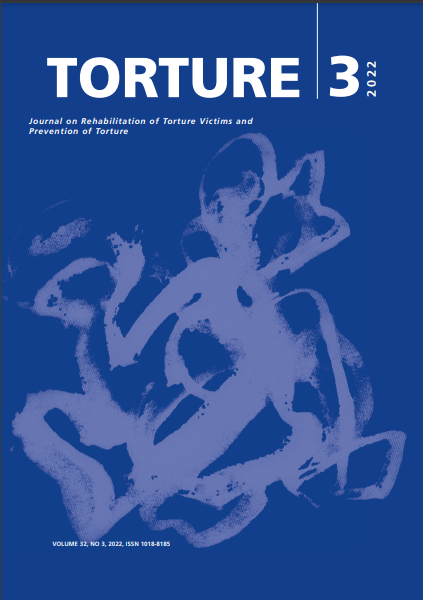
Torture Journal: Journal on Rehabilitation of Torture Victims and Prevention of Torture
Vol. 32 No. 3 (2022)This issue introduces the revised edition of the Istanbul Protocol. The Editorial offers a summarised guide that outlines the new elements and main variations of the recently launched 2022-version. You will find it available in English, French and Spanish.
The contribution from Ergun Cakal opens the scientific section of this issue, presenting a doctrinal review which consolidates normative understandings of adequate prisoner food. His paper discusses the aspects relevant to assessing when and how food provision is considered inadequate through a systematic exploration of international and regional standards.
Phyu Pannu et al. continue exploring resilience-promoting factors for refugees who have survived torture to understand how these impact the relationship between torture and mental health.
Aaron Gallagher et al. present a student-run clinical study to investigate the changes in asylum seekers’ profile over 3 years. They argue that understanding background and trauma profile of newly displaced populations is fundamental to meet their health needs and integration.
The section Perspectives compiles two papers. In the first one, Daniel J. N. Weishut discusses the potential participation of psychologists in IP-based physical examinations as it elaborates on the author’s perspective as clinical psychologist and relevant literature. In the second one, Maria Hartwig and Mark Fallon argue that the American government’s post 9-11 torture program was a big deceit, in that the designers, executors and enablers knew all along that torture does not elicit reliable information. The authors review the government’s own research and discuss the ways in which methods known to be unreliable were implemented, most saliently at the detention facility at Guantánamo Bay, against international law and human rights.
The Continuous education section includes a case where Cynthia Luo et al. argue the limitations of administering psychological surveys implying the development of ways to identify, mitigate and overcome such limitations.
In our News section, we celebrate the launch of the 2022-revised version of the Istanbul Protocol.
Finally, this issue includes the forthcoming call for papers for two special sections on survivors engagement and livelihoods in rehabilitation, in which we encourage you all to submit papers, in case you have relevant research and/or experiences to share in these areas.
-
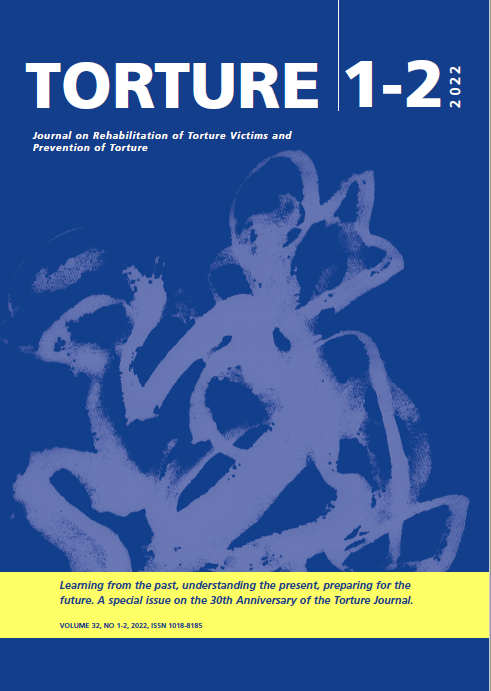
Torture Journal: Journal on Rehabilitation of Torture Victims and Prevention of Torture
Vol. 32 No. 1-2 (2022)This is an outstanding double-issue which celebrates the 30 years of the Torture Journal through commemorative contributions from authors who have had a long trajectory in the fight against torture or accompanied the evolution of the Journal.
This valuable collection of 25 papers represents different perspectives - from the anthropological to the epidemiological, the legal to the clinical - on how authors have experienced this journey.
The double issue is divided into three sections: 1) Learning from the past; 2) Understanding the present; and 3) Preparing for the future.
The first section is essential reading for anyone who wants to understand the history and viewpoints of the many individuals who have gathered around and contributed to the Torture Journal. It includes contributions from Hans Draminsky Petersen, Mahmud Sewail, June Pagaduan Lopez, Inger Agger, Vincent Iacopino, Henrik Døcker, Christian Pross, Peter Vesti, Diana Kordon and Darío Lagos, José Quiroga and Elizabeth Lira, Jorge Aroche and Mariano Coello, and Lilla Hárdi. The second section reflects on the present with contributions from Sharon Shalev, Edith Montgomery, Michael Wessells, Nora Sveaass and Felice Gaer, Stephen Soldz, and Masha Lisitsyna. And the third section explores the future with papers from Derrick Silove, Nimisha Patel and Amanda Williams, Metin Başoğlu, Tony Reeler, Carlos Madariaga, Stuart Turner and Pau Pérez-Sales.
All in all, this unique issue is a modest illustration of the plurality of voices that have found their space in the Torture Journal and represents the many challenges we have overcome together over the past 30 years while acknowledging the vitality of a field that has countless challenges still to face.
Finally, this issue also includes the forthcoming call for papers for two special sections on survivor engagement and livelihoods in the rehabilitation of torture survivors, in which we encourage you all to submit papers, in case you have relevant research and/or experiences to share in these areas.
-
Torture Journal: Journal on Rehabilitation of Torture Victims and Prevention of Torture
Vol. 31 No. 3 (2021)In the celebration of the journal’s 30th anniversary and pending the publication of the Special -Commemorative issue, this last number of 2021 has two Special Sections.
On the one hand, the second part of the section on Enforced Disappearance as Torture published in our previous issue is complemented by four additional papers: Natalia Huerta and Edith Escareño examine the case of the 43 students who disappeared in Ayotzinapa (Mexico) in 2014. How the Mexican state’s mistreatment suffered by the survivors and their families has provoked elements of suffering that the authors consider amounting to ill-treatment or torture. Anne Margrethe Sønneland publishes the results of several years of research with witnesses and victims of the trials of perpetrators of enforced disappearance in Argentina, pointing out those elements that could constitute elements of re-traumatisation or additional suffering adding to previous burdens. Mayra Eliana Nuñez analyses the decreasing role of relatives and witnesses in legal proceedings for enforced disappearance before the Inter-American Court of Human Rights. In an overburdened court, neither experts nor victims are allowed to speak. The process before the Court is progressively becoming more of a legal dialogue between the parties, while experts and victims are relegated to add through documentary contributions. In the authors’ opinion, this means that much of the reparatory value of the Court over the suffering of the victims is lost. Finally, Vesna Stefanovska reflects on the El Masri judgement in the European Court of Human Rights and its relevance for victims of enforced disappearance.
The author elaborates on previous literature stating that cases of Extraordinary Rendition constitute forms of enforced disappearance and should be treated as such by international jurisprudence.On the other hand, this issue includes a Special Section on dental care for torture survivors with two papers that complement each other. According to epidemiological data, about 35% of torture victims have suffered trauma to their mouth or teeth. Anne Catrin Høyvik and colleagues conducted a qualitative study with 10 torture survivors from different cultural backgrounds attending dental facilities. Karlsson and colleagues conducted semi-structured interviews with dentists and professionals from rehabilitation centres in Norway. Together, the two studies provide a unique perspective on the difficulties and risks of re-traumatisation of victims and the low detection capacity and knowledge
of the professionals who should care for them. Important policy recommendations emerge from both studies. Aisling Hearns and collaborators present a validation study of the International Trauma Questionnaire as an instrument for the early detection of Complex Posttraumatic Stress (CPTSD). Their data support the idea that PTSD and CPTSD are distinct entities and that both should be detected in torture survivors attending rehabilitation centres.Alongside this is the continuing education section, which discusses the forensic documentation of electric shocks as a form of torture. We want to pay an extraordinary tribute to Dr June P. Lopez, a founding member of the IRCT and a key figure in the fight against torture in recent decades, who passed away this month. Along with an obituary by Dr Aurora Parong, friend and fellow, we include the text of an essay that Dr June Lopez was writing for the 30th anniversary of the Journal. Although she considered it an unfinished text, we have decided to publish it as the best tribute to a tireless fighter who leaves behind an indelible mark.
-

Torture Journal: Journal on Rehabilitation of Torture Victims and Prevention of Torture
Vol. 31 No. 2 (2021)We present in this Issue 2021/2 the first 6 contributions of the special section on enforced disappearance as torture, while the remaining 4 will appear in Issue 2021/3. We thank the Guest Editors, Bernard Duhaime and Mariana Castilla, for their valuable contribution to the special section on enforced disappearances.
Manon Bourguignon at al. text analyses how grief is experienced by victims of such crimes who are endlessly confronted with uncertainty and exacerbated impunity. She makes a comparative analysis of the different conceptualisations used to describe the grief of relatives and proposes key elements that are common to all of them.
Nicolas Morales addresses the impact of inadequate investigations and reparation measures regarding enforced disappearances, which occurred in the region of Paine, in Chile, during the Pinochet dictatorship. He stresses the importance of first-person experiences of the relatives of the disappeared which make it possible to account for the subjective and collective dimension of forensic identification. He also discusses the importance of better understanding the intergenerational impacts of such crimes.
The concept of victimhood is analysed by Mina Rauschenbach et al. in their study dealing with the recognition of victims’ status in El Salvador and in Colombia, two countries in which enforced disappearances have occurred on a massive scale during internal armed conflicts. She considers how such status is legally defined in both countries and how it impacts their experiences in the judicial system.
Alejandra Vicente and Eva Nudd examine the importance of the phenomenon of disappearances in Africa, a region where this crime is underreported. The authors also describe the current discussions held by the African Commission on Human and Peoples Rights on the topic, in particular the evolution of draft guidelines on enforced disappearances in Africa currently being developed by the Commission’s Working Group on Death Penalty, Extra-Judicial, Summary or Arbitrary Killings and Enforced Disappearance.
Aïcha Madi presents a case study of enforced disappearances in Algeria showing that the impact crosses more than one generation and remains as a hidden wound in society that needs to be addressed by all political actors.
Inamul Haq’s contribution discusses how enforced disappearances have impacted women in Kashmir, more specifically how the latter have been marginalised as “half widows”, lacking adequate rehabilitation measures to address the emotional and psychological trauma that they face on a daily basis.
This issue also includes three regular scientific papers not part of the special section. Ebbe Munk-Andersen et al. present the positive results of a structured questionnaire used for screening asylum-seekers in Denmark, Dongmi Kim et al. review the efficacy of pharmacotherapy for major depressive disorder and post-traumatic stress disorder from torture, showing the lack of strong evidence for any the treatments proposed. Karen Fondacaro et al. published in 2018 in Torture Journal a paper explaining the Chronic Traumatic Stress Framework as a conceptual model to guide empirical investigation and mental health treatment for refugees and survivors of torture. In this issue, they complement that paper with a second paper on Chronic Traumatic Stress Treatment.
Moreover, it is with great pleasure that we welcome a Forensic Case Series, a new section of the Torture Journal edited by Ben McVane and James Lin. Cases in this section may describe unique or uncommon physical and psychological findings, illustrate barriers to a thorough evaluation, or present features that make effective articulation of a survivor’s claim challenging. Case discussions aim to provide further information about findings or reflections on how challenges were approached. They also aim to address common misconceptions about the clinical evaluation and the experience of torture.
All together, this makes 160 pages, the longest issue in the history of the Journal. You, the readers and authors, are responsible for the increasing growth of Torture Journal: a home for all.
-
Torture: Journal on Rehabilitation of Torture Victims and Prevention of Torture
Vol. 31 No. 1 (2021)Pau Pérez-Sales introduces this issue with an Editorial which conceptualises and documents threats in the context of ill-treatment and torture. He provides a theoretical reflection on what threats are, what types exist and how they impact the survivor from a medical and psychological perspective, providing a framework of understanding that will hopefully improve conceptual and practical assessment, documentation and qualification.
Ergün Cakal continues with a discussion on the characterisation of threats as psychological torture in international law. His paper suggests that an assessment of the perception of practice and proximity of state authorities to harm could help qualify such threats as torturous.
This issue continues with the contribution from Nicholas Nelson et al. who present a cross-sectional study on patterns of torture among forcibly displaced Eritrean men in the US. This is the first study of its kind and provides valuable data on prevalent methods, and clinical impacts in a sample of 59 survivors assessed using the Istanbul Protocol.
Following the call for contributions from the Journal, Juliet Cohen et al. present preliminary data on remote medico-legal assessment by telephone during Covid-19, showing that it can be safely used with some special considerations assessed in the paper. We are now expecting results from the comparison with the video assessment.
Vipin Vijay et al. present a qualitative study on the experiences of survivors of commercial sexual exploitation at RP homes in India with an analysis of the elements that facilitate the rehabilitation according to the vice of survivors.
The paper by Frank Hofmann et al. describes the implementation of a pilot project on the use of EMDR in children in post-conflict settings conducted in Northern Iraq.
The IRCT conducted an open discussion on Survivor Engagement in the work of Rehabilitation Centers for torture survivors. Berta Soley has summarised the conclusions and included an interview with Lynne Walker that shares how the Tree of Life Trust has incorporated this perspective for more than ten years.
This issue also includes the Letter to the Editor by Jesús Antona which exposes the proneness of Chilean democracy, exposing the Catrillanca case and the Temucuicui community arrest.
In recent months, during a year when organisations that provide services for survivors of torture faced new challenges during the global COVID-19 pandemic, some of the people who have been leading the anti-torture movement for years have passed. We have paid tribute to Javier Enriquez Sam (1960-2021), Gerald “Jerry” Gray (1935-2020), Sister Jean Abbott (1943-2021), Jose María “Chato” Galante (1948-2020), Gianfranco De Maio (1963-2020) and Sister Dianna Ortiz (1958-2021). Many more people have left us in these months, but let the testimony of Javier, Jerry, Jean, Chato, Gianfranco and Dianna serve as a tribute. They have left behind them a light that we will try to follow.
Finally, this issue also includes the forthcoming call for papers for the special section on racism, ethnocentrism and torture by police and security services.
-
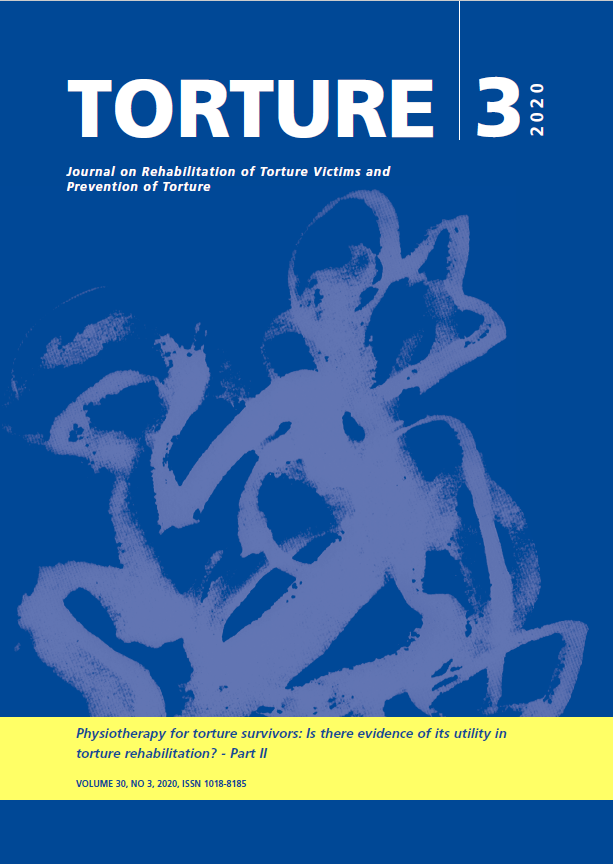
Journal on Rehabilitation of Torture Victims and Prevention of Torture
Vol. 30 No. 3 (2020)This issue of Torture Journal initiates with an Editorial by Pau Pérez-Sales, Editor-in-Chief, which examines the state of the art of deprivation and manipulation of food as a torture method.
This edition includes the second part of the Special Section on Physiotherapy in work with torture survivors.
Laura Pizer Gueron and MaryAnn de Ruiter present the results of a survey conducted among professionals worldwide regarding the availability and use of physiotherapy services with torture survivors. The same team presents the development and detailed explanation of, and initial assessment data from the Group Physiotherapy Model with torture survivors that has been developed by the Center for Victims of Torture. Anne-Mette Karrer et al. present an evaluation of the cultural acceptability and feasibility of a School Pain Treatment programme for populations affected by trauma in Arab countries. Finally Marie Nordheim Alme et al. describe the PREP programme; international experience of collaboration in training processes for physiotherapists working with torture victims.
This number also comprises regular articles in which Marta Guarch-Rubio et al. present worrying data on the prevalence of situations of ill-treatment or torture of asylum seekers arriving to Serbia. Moa Nyamwathi Lønning et al. present a nation-wide study on public rehabilitation systems for torture victims in Norway, and Maria-Angeliki Psyrraki et al. present a study carried out in Athens on the concept of rehabilitation and the importance of mutual support networks in the Congolese refugee population.
The issue concludes with a book review, and a letter to the editor.
-
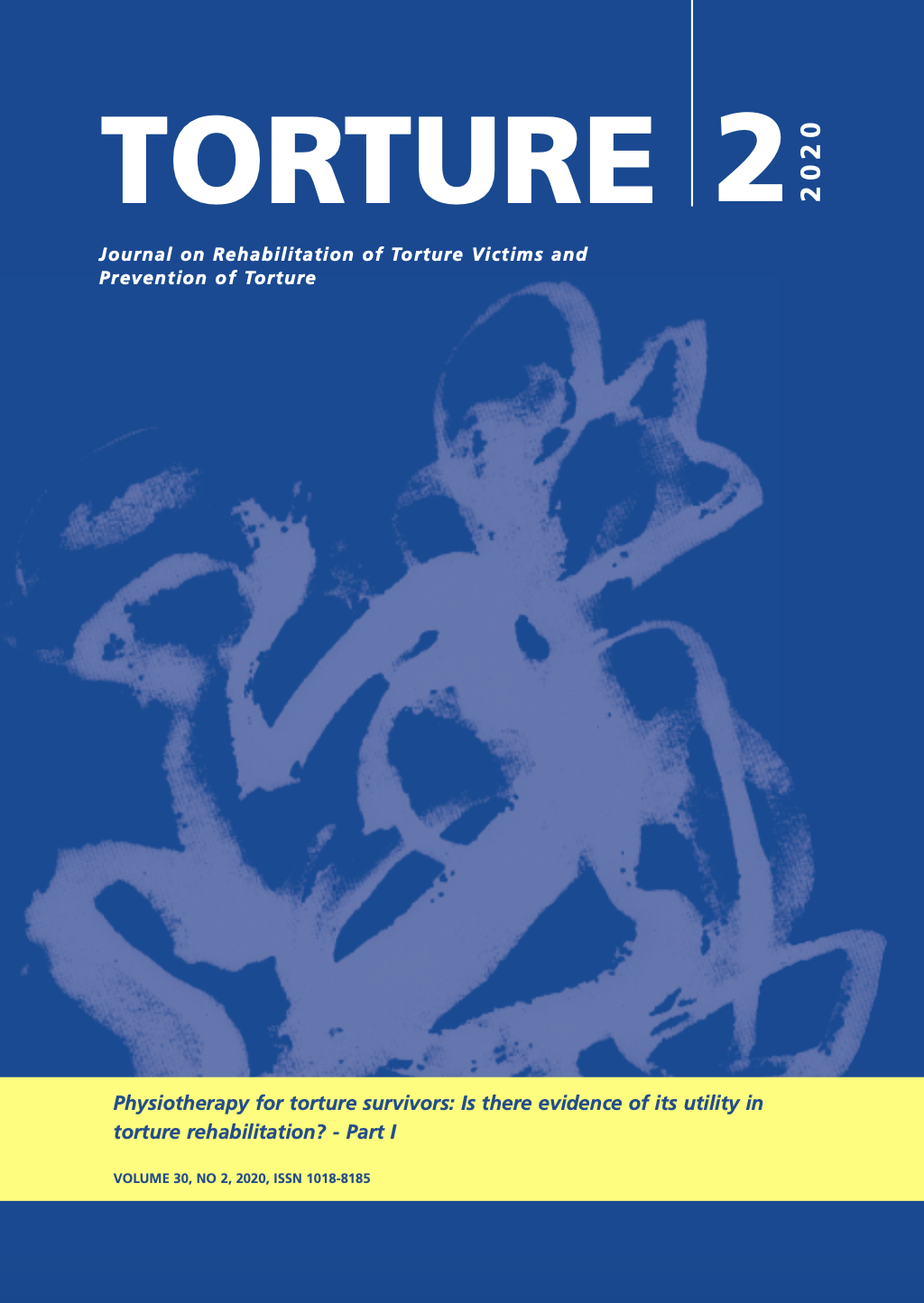
Journal on Rehabilitation of Torture Victims and Prevention of Torture
Vol. 30 No. 2 (2020)In this issue, the Editorial reviews the effects of COVID-19 on torture survivors and their communities.
This issue also includes Part I of a Special Section on Physiotherapy as Torture. Under the Special Section:
Iselin Dibaj, Joar Halvorsen, Leif Ottesen Kennair and Håkon Stenmark contribute a narrative review on challenges in trauma-focused therapy for torture survivors with PTSD and chronic pain, showing that there is still not enough support for the widely accepted assumption that addressing trauma can improve chronic pain. April Gamble, Salah Hassan Rahim, Ahmed M. Amin Ahmed and Jeff Hartman present the results of a pilot study on the Effects of a Combined Psychotherapy and Physiotherapy Group Treatment Program for Survivors of Torture with very preliminary, although promising results. Tanju Bahrilli and Hamiyet Yüce present a study on Basic Body Awareness Therapy in hunger strike victims with Wernicke Korsakoff Syndrome, showing improvement in different quality of life indicators in survivors that had been severely handicapped for years.
Additionally, Paula Suárez-López presents a review on the potential of epigenetic methods to provide evidence of torture. Genetic markers, now still at an early stage of development, show enormous potential to detect long-term and trans-generational impacts of chronic trauma in general.
Marie Brasholt, Brenda van den Bergh, Erinda Bllaca, Alba Mejía, Marie My Warborg Larsen, Anne Katrine Graudal Levinsen, and Jens Modvig present results on a study conducted in Albania and Honduras on the risk of sanctions following visits by monitoring bodies to detention centers, that shows that this is a relevant and neglected area in the prevention of torture. The results are alarming and show that a very significant percentage of people interviewed suffer some kind of harassment or reprisal following the visits.
This issue includes a Debate in which, Sara López poses the complex question: What are the ethical dilemmas and proposed criteria when a (potential) perpetrator asks for forensic documentation of their own alleged torture. The author proposes three criteria that can be applied by forensic experts and organizations. Four expert authors, Juliet Cohen, Elizabeth Lira, Henry Shue and Onder Ozkalipci, provide insights on the proposal with a final wrap-up and answer from the author.
-
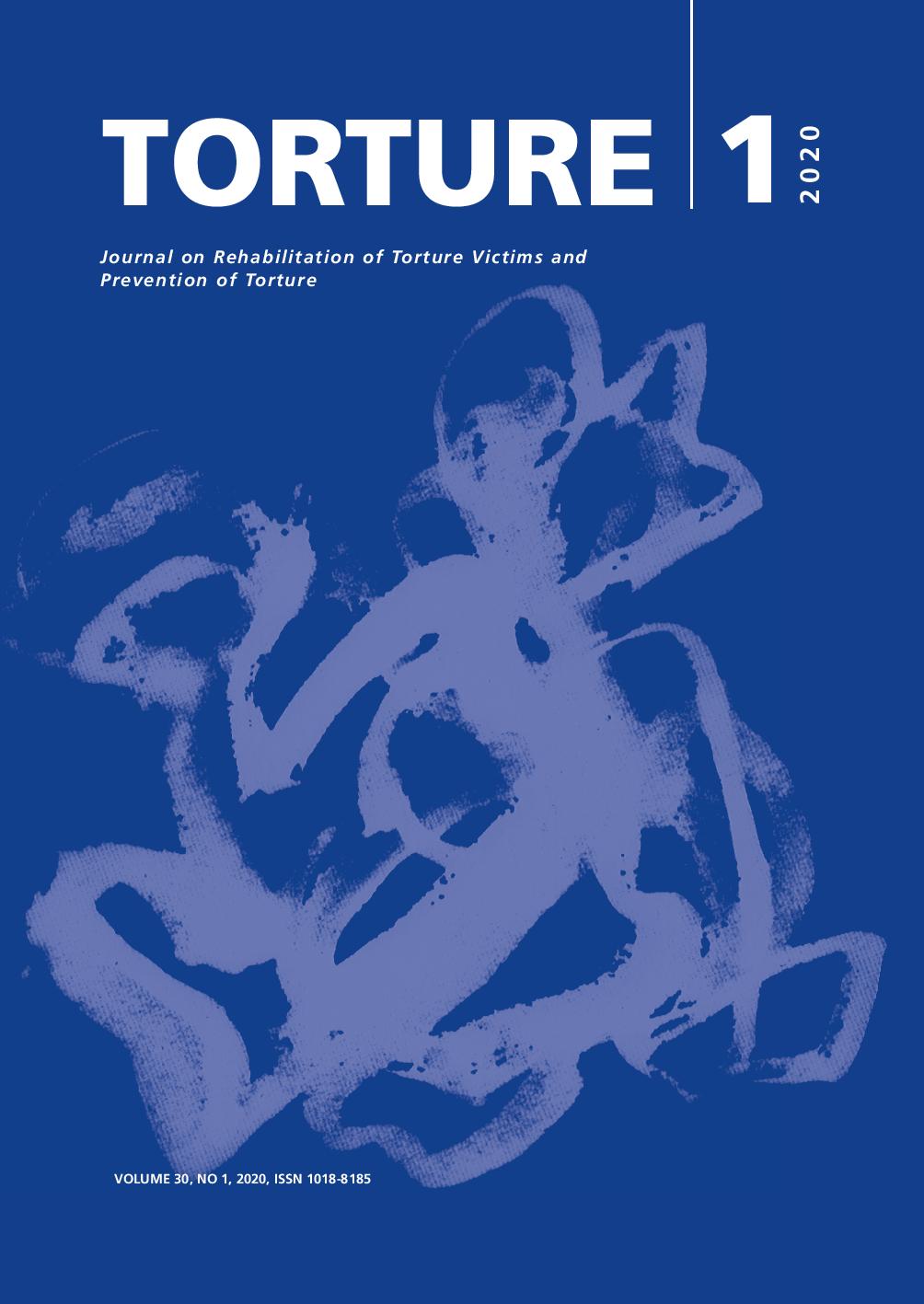
Journal on Rehabilitation of Torture Victims and Prevention of Torture
Vol. 30 No. 1 (2020)Scientific contributions in this issue include presentation of a Complex Care Approach (CCA) for treatment of torture victims that integrates medical, psychological, psychosocial and existential elements from a holistic perspective, and apply it to an hypothetical paradigmatic case. A short scientific report presents a series of 40 cases of male victims of sexual torture in India with severe urological sequelae in defining the concept of parrilla torture and showing the interplay between medical and psychological sequels.
This issue also includes a short research report that presents data from an early analysis of the safeguards in the medical examination of people detained in Catalonia (Spain) in the framework of civic protests. The analysis serves as a reminder that the ethical principles of the Istanbul Protocol must be respected in all circumstances. Their data evidences a request for more thorough investigation by the Spanish authorities.
Conversion therapies are still common practice in many countries around the world as a recent IRCT report has shown. The Independent Forensic Expert Group (IFEG) has been working over the past two years on an analysis of these practices as a form of ill-treatment or torture. The reader will find a landmark document: the IFEG's latest Statement with the conclusions and recommendations to the international legal and medical communities.
Johan Lansen, one of the great European figures of the 20th century in the work with torture survivors, from his own experience as a Holocaust survivor, passed away in November 2019. Torture Journal reprints, as a posthu- mous tribute, the article that he published in the Journal of Medical Ethics more than 15 years ago with personal reflections on the ethical dilemmas of working with perpetrators.
This issue also presents the challenging path to criminalisation of torture and enforced disappearances in Thailand that has been ongoing for over a decade. The Special Suppression and Prevention and of Torture and Enforced Disappearance Bill, introduced in 2014 remains entangled in the Thai legislative process.
-
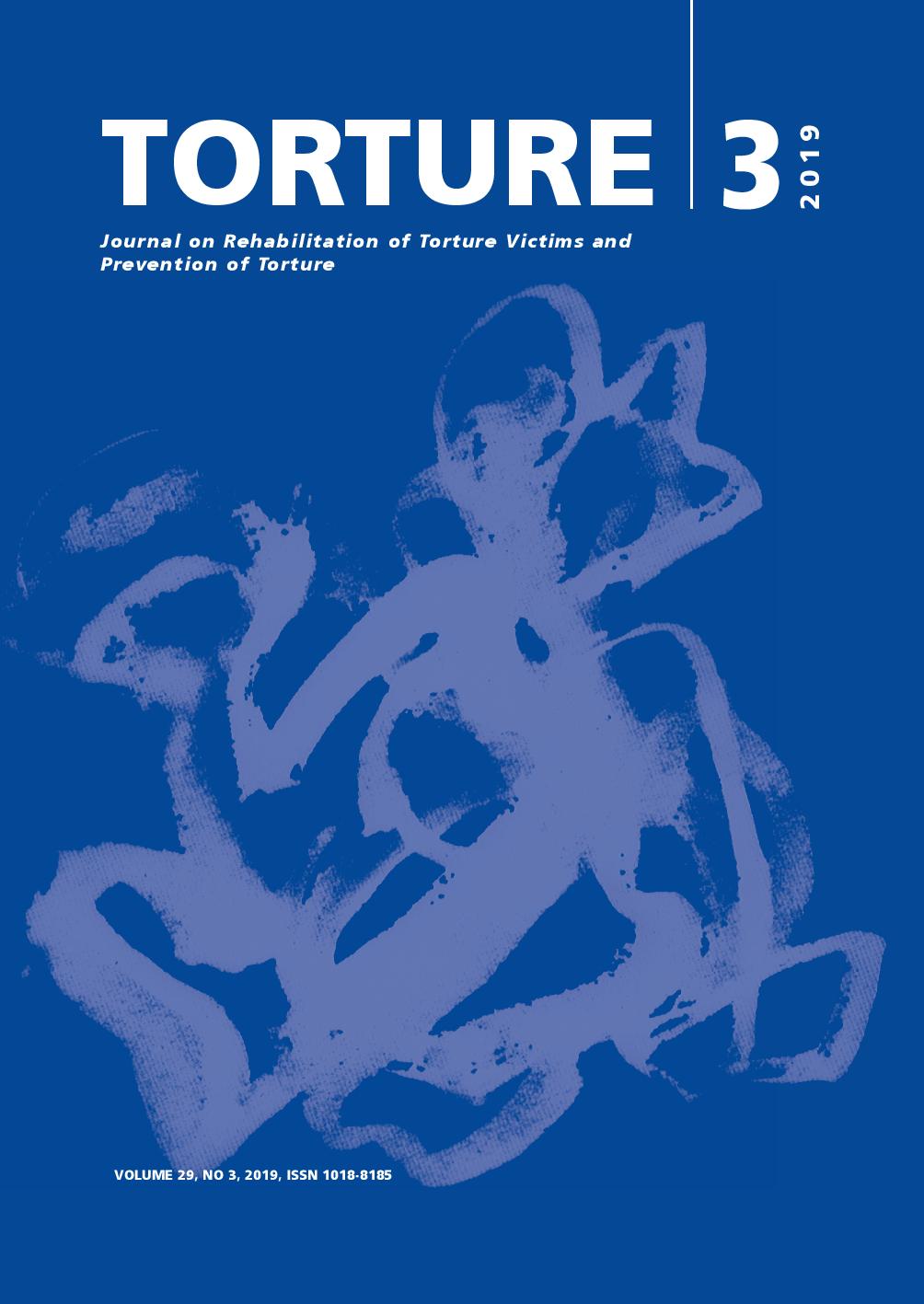
Journal on Rehabilitation of Torture Victims and Prevention of Torture
Vol. 29 No. 3 (2019)This issue of the Torture Journal takes its focus on measuring torture rehabilitation processes and results. Scientific contributions on this subject include a measurement of rehabilitation outcomes with an instrument designed at the Marjorie Kovler Center in Chicago; a validation study examining diagnoses of Post-Traumatic Stress Disorder (PTSD) and Complex Post-Traumatic Stress Disorder (CPTSD) in refugee and torture survivor populations; and a study of gender-based violence in Honduras, El Salvador and Guatemala.
The issue also comprises an applied perspective on organizational development in torture rehabilitation programs and two letters to the editor addressing involvement of medical personnel in torture in Syria and a response to the concept of psychological torture.
Finally, Secretary-General of the International Rehabilitation Council for Torture Victims, Lisa Henry, and Chief Executive Officer of STARTTS Centre in Australia, Jorge Aroche, provide an open letter to the Torture Journal readers and a celebratory text of STARTTS' 30th anniversary respectively.
A corrigendum is added to correct the Editorial of Vol. 29 (2).
-
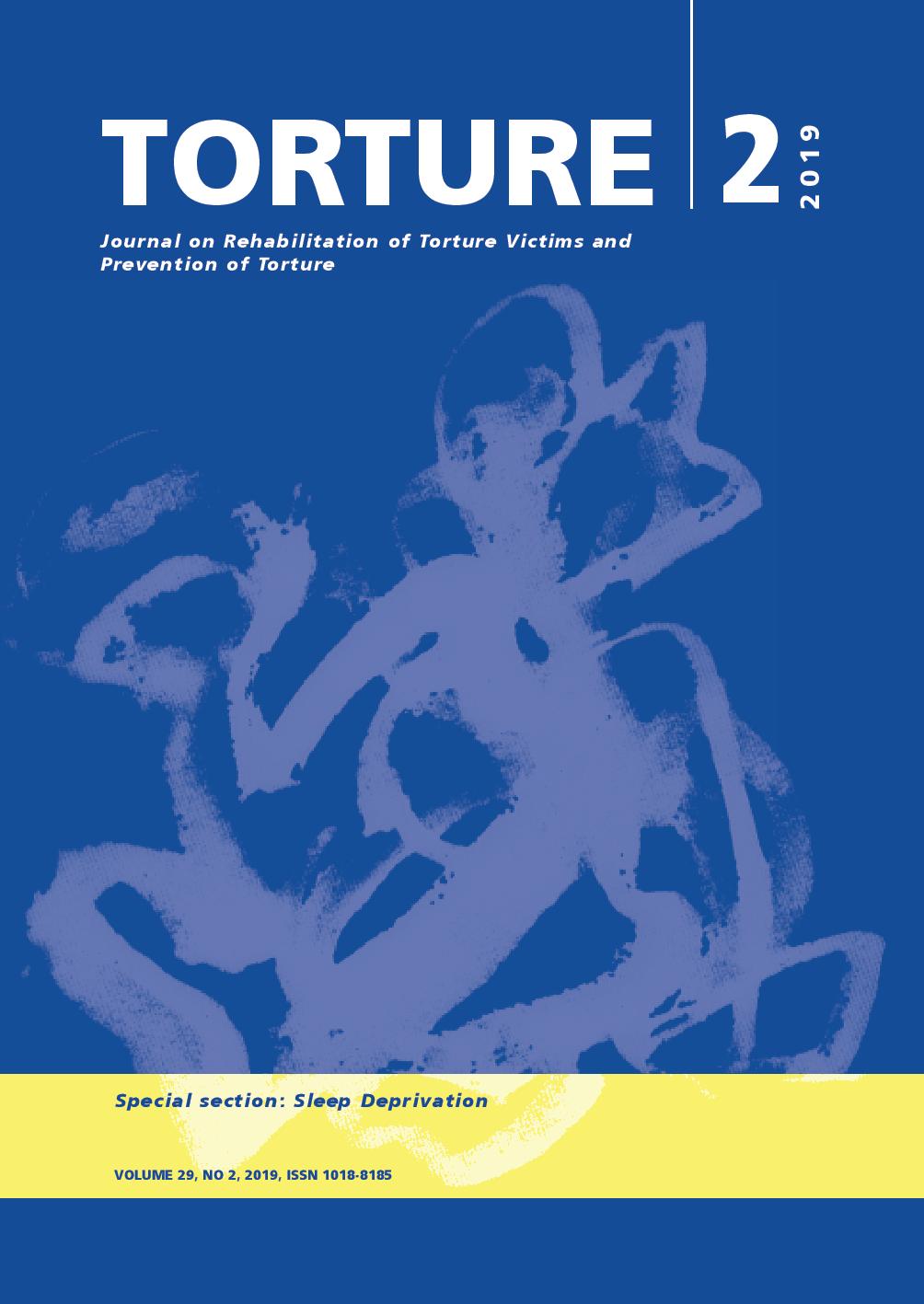
Torture Journal: Journal on Rehabilitation of Torture Victims and Prevention of Torture
Vol. 29 No. 2 (2019)This issue of the Torture Journal examines sleep deprivation as a method of torture. The editorial proposes that intentionally forcing a person to have less than 6 hours of continuous, restful sleep must be considered a form of degrading treatment that could amount to cruel and inhuman treatment, and suggests that when daily sleep deprivation is intentionally prolonged in a sustained manner for three days or more, it should be considered as a form of torture in itself.
The issue includes a review of the prohibition of sleep deprivation as torture or ill-treatment in international law and the text of a Protocol for Medico-Legal Documentation of Sleep Deprivation with an accompanying explanatory article covering the development and pilot testing of the Protocol. The section also includes a study carried out in Palestine, documenting the impact of sleep deprivation on a sample of Palestinian detainees.
The issue is further complemented by an epidemiological study on knowledge relating to torture amongst medical professionals in Tanzania and a case report from Australia exemplifying narratives of Tamil survivors of sexual violence. A Debate section that discusses the standing of the Istanbul Protocol through the case of Mr Firas Tbeish is also included. Finally, a book review and letter to the editor close the issue.
-
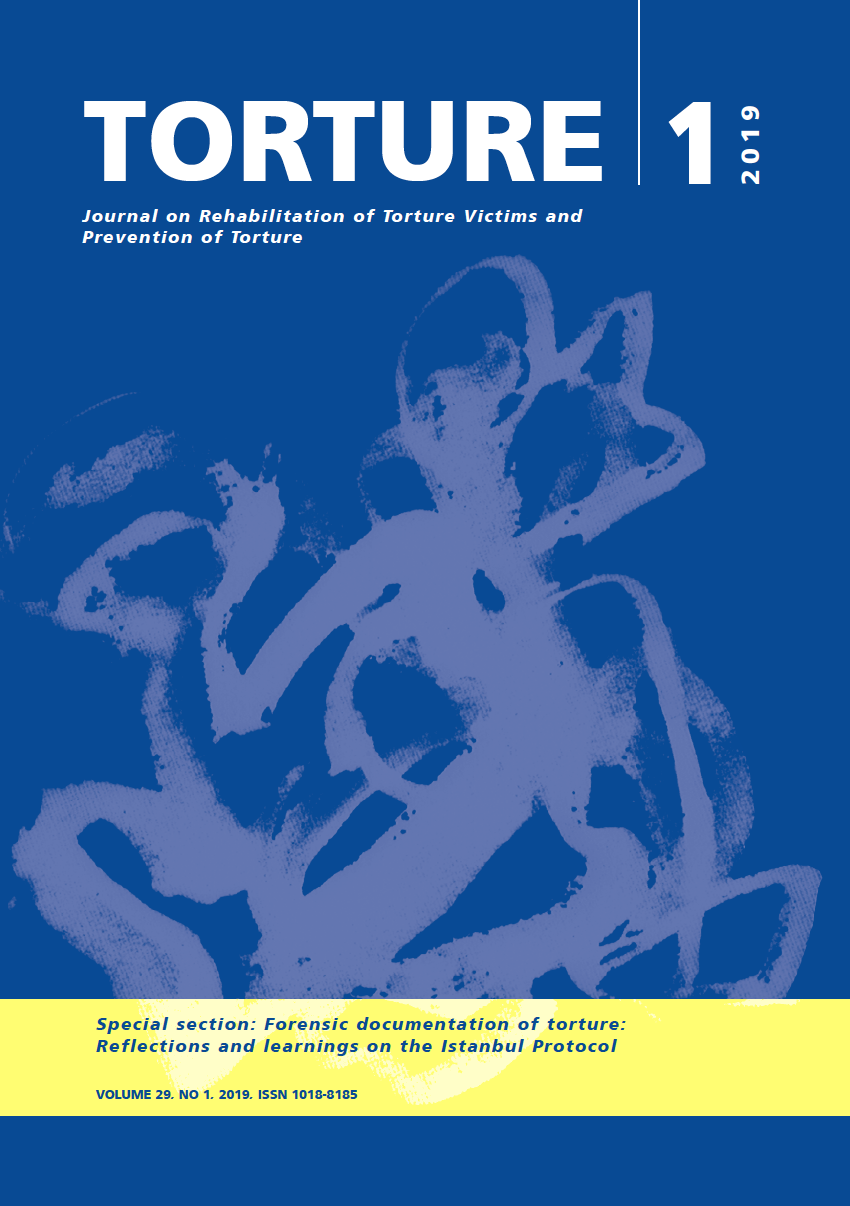
Torture Journal: Journal on Rehabilitation of Torture Victims and Prevention of Torture
Vol. 29 No. 1 (2019)This issue of the Torture Journal reveals new, innovative insights on torture documentation and rehabilitation approaches from leading academics and researchers globally. The focus of the latest issue is on forensic documentation of torture. The issue explores documentation in detail regarding its strengths, limitations and innovative new ideas, such as documentation procedures among specific sub-groups. Fresh research and perspectives on sport-based rehabilitation, as well as other key topics, also comprise the issue.
-
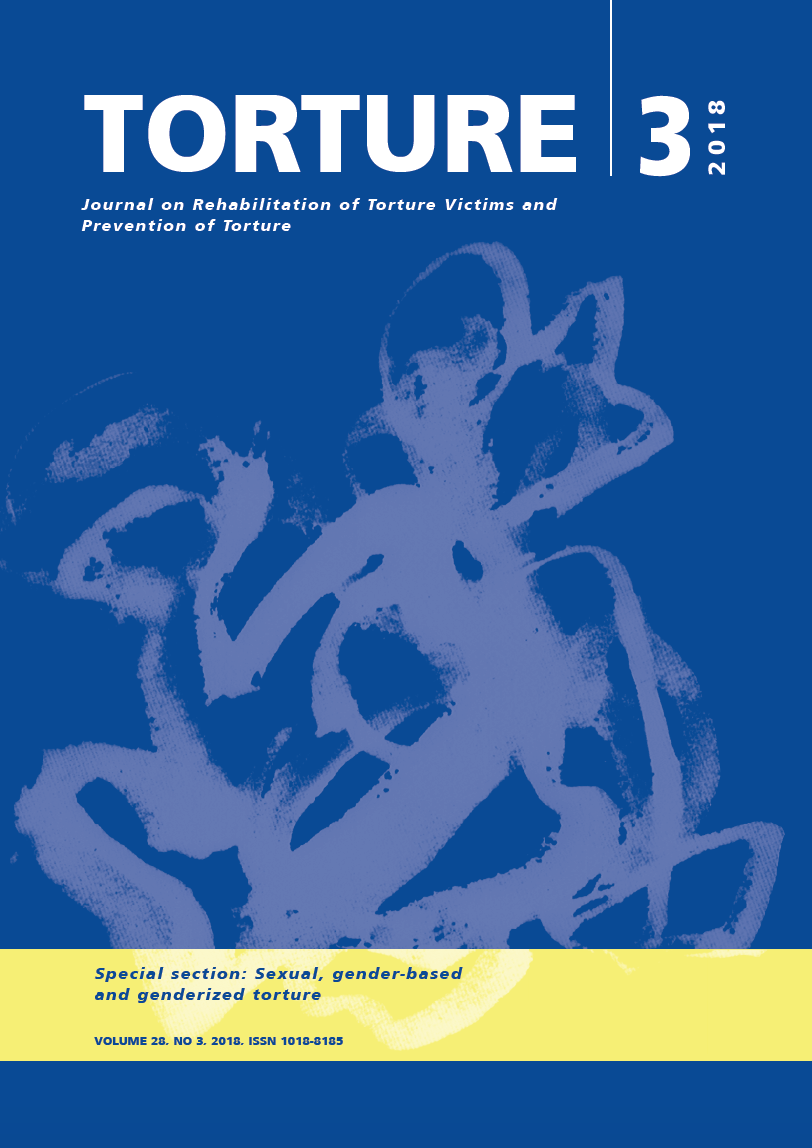
Torture Journal: Journal on Rehabilitation of Torture Victims and Prevention of Torture
Vol. 28 No. 3 (2018)This issue of the Torture Journal examines the impact of sexual torture (and other forms of torture) in diverse settings around the world and identifies innovative and culturally appropriate rehabilitation approaches. The issue includes a special section on sexual, gender-based and genderized torture.
-
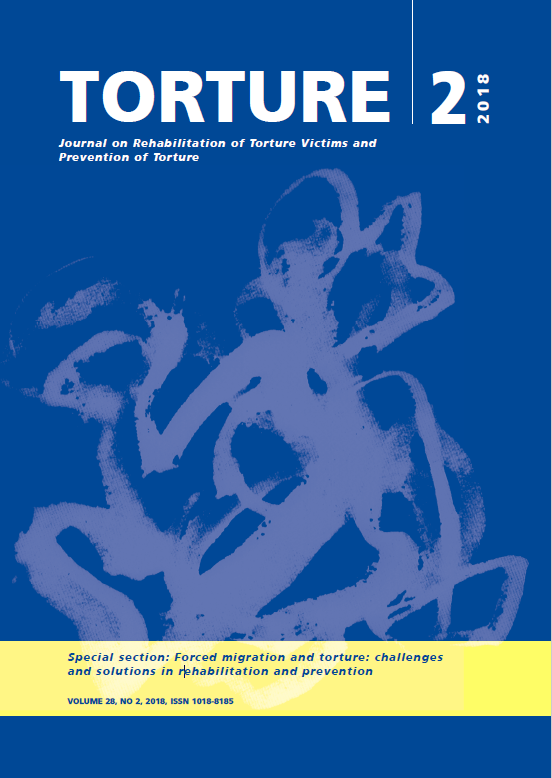
Torture Journal: Journal on Rehabilitation of Torture Victims and Prevention of Torture
Vol. 28 No. 2 (2018)Special section: Forced migration and torture: challenges and solutions in rehabilitation and prevention
Forced migration leads to many challenges for rehabilitating torture victims. Challenges and solutions in the forced migration context are investigated and addressed in the latest informative issue of the Torture Journal.
-
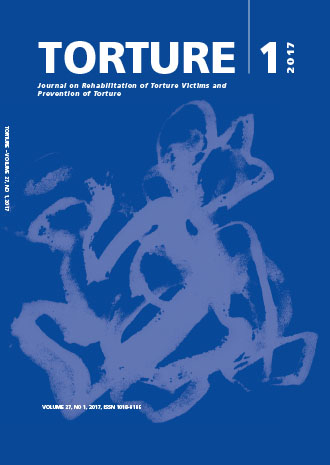
Torture: Journal on Rehabilitation of Torture Victims and Prevention of Torture
Vol. 27 No. 1 (2017) -
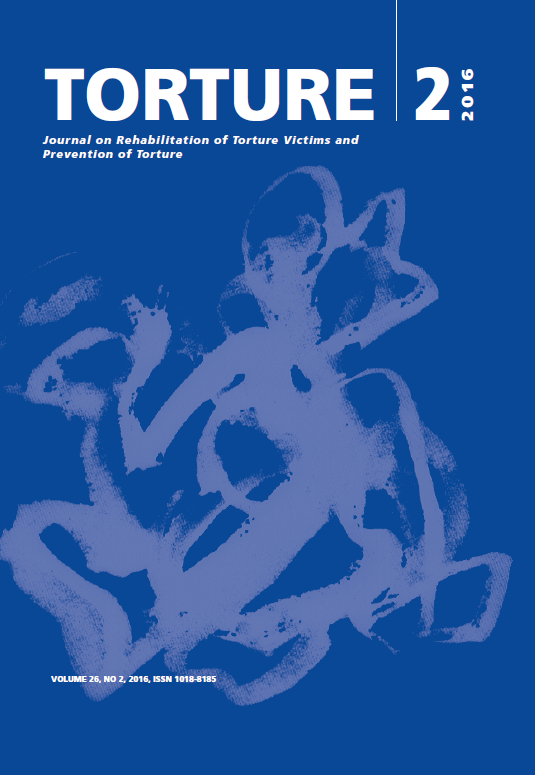
Torture Journal: Journal on Rehabilitation of Torture Victims and Prevention of Torture
Vol. 26 No. 2 (2016)Long-running themes and previous research are given new life in this issue, Lilla Hárdi's last as Editor in Chief.
-
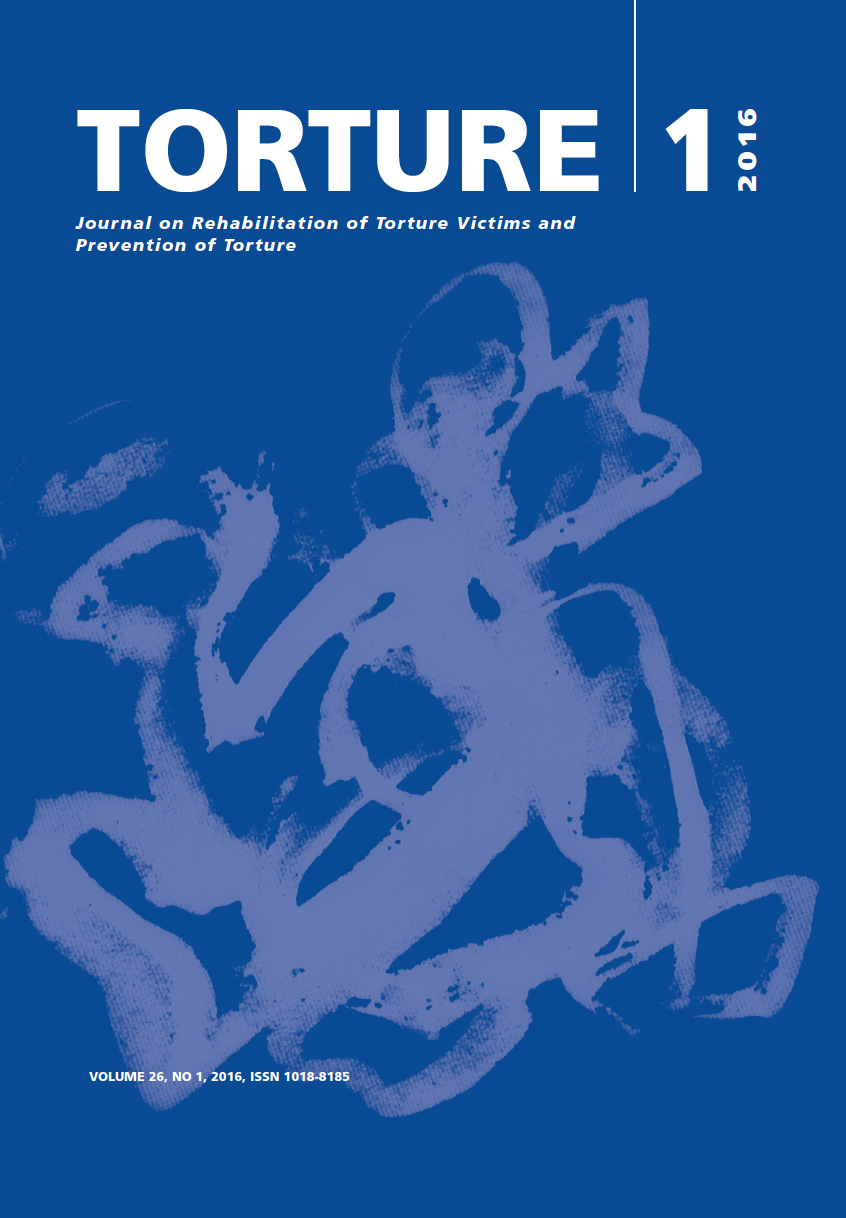
Torture Journal: Journal on Rehabilitation of Torture Victims and Prevention of Torture
Vol. 26 No. 1 (2016)"In such a complex clinical landscape, influenced by a dizzying array of different social, psychological and environmental factors, how can a clinician know what treatment has the best outcome for a particular person or group? And, how can researchers identify areas and methods for research?"
Lilla Hárdi, MD, Editor in Chief
This issue of the Toture Journal grapples with these questions and others.
-
Torture Journal: Journal on Rehabilitation of Torture Victims and Prevention of Torture - Supplementum
Vol. 24 No. 2 (2014)Input description

